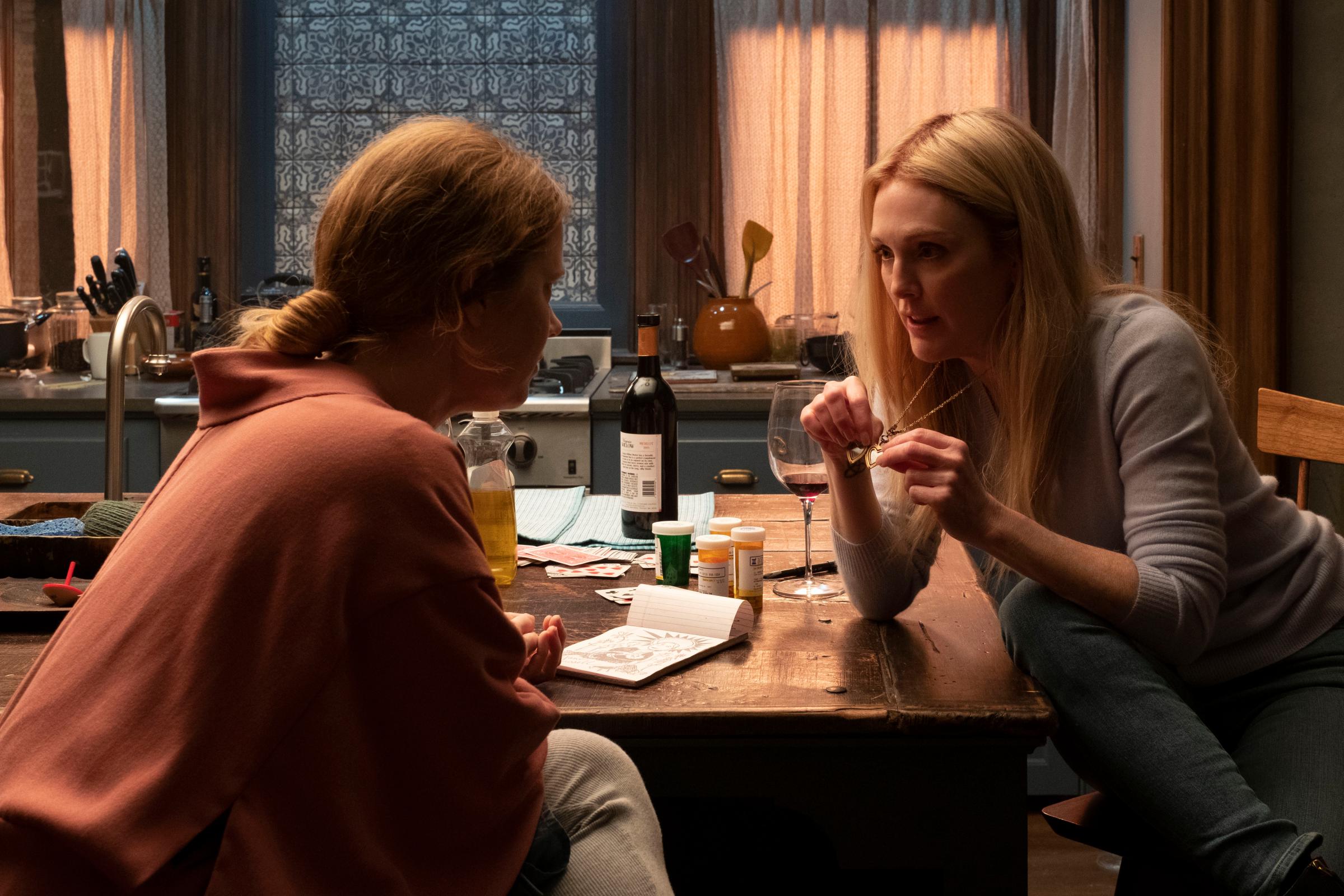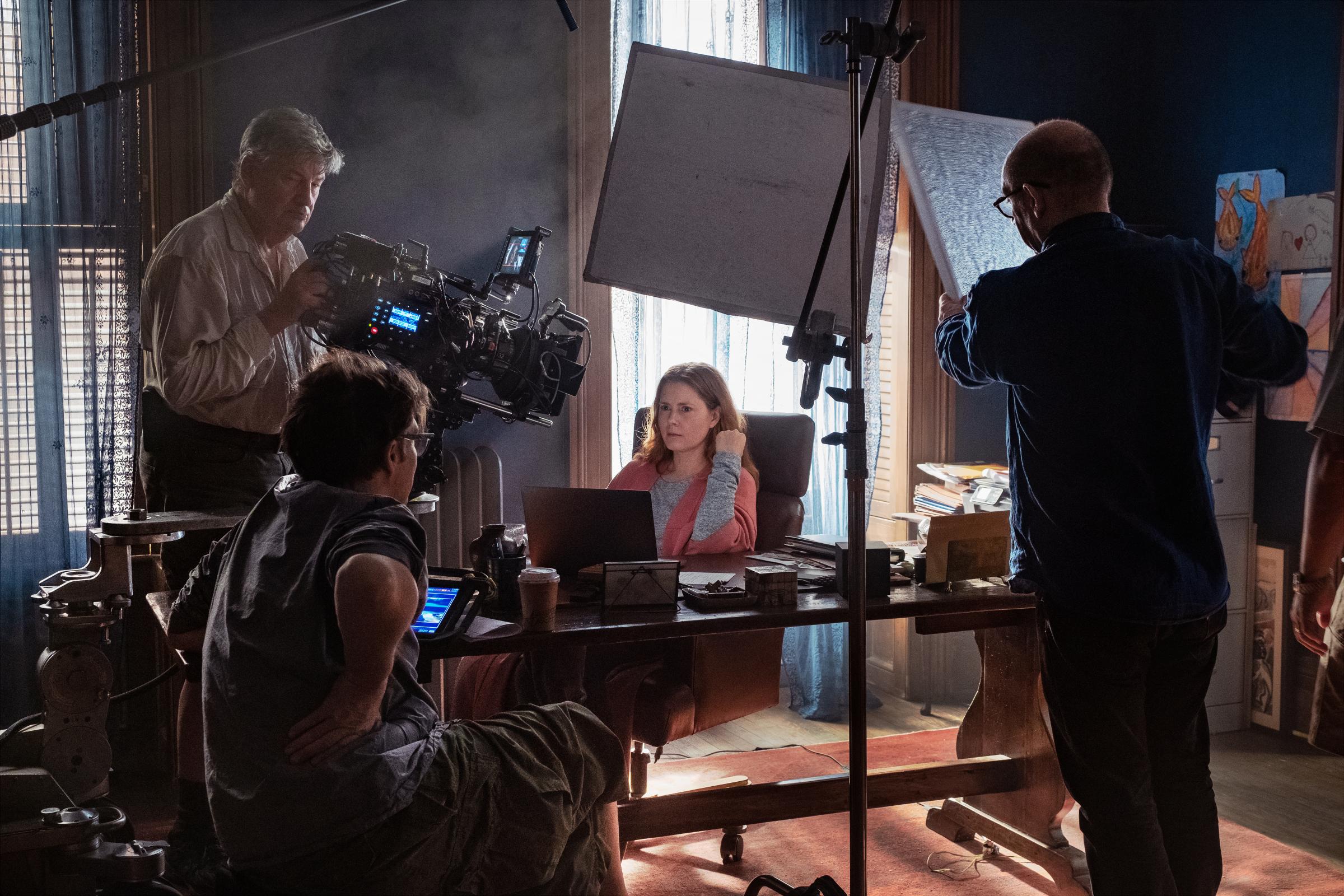For The Woman in the Window, the journey from book to screen has been a long one. Fox 2000 initially secured the film rights to the suspense novel in 2016—two years before the book came out and back when the identity of its now controversial author was not yet publicly known. Amy Adams signed on to play agoraphobic child psychologist Anna Fox in 2018. The film was due to arrive in October of the next year, delayed another year after Disney acquired Fox, then sold to Netflix during the pandemic, with the release date finally landing in May 2021.
Now, The Woman in the Window is finally making its long-awaited debut on the streaming platform on May 14. The movie, based on the novel by A.J. Finn (whose real name is Dan Mallory, but more on that later) is about a woman (Adams) living in New York City who believes she’s witnessed a horrible crime across the street while spying on her neighbors’ home. Her decision to insert herself into her neighbors’ business has unforeseen consequences—ones that threaten to upend her whole world.
In addition to Adams, the film’s all-star cast includes Julianne Moore, Gary Oldman and Anthony Mackie. Joe Wright (Pride & Prejudice, Atonement) directed and Pulitzer Prize-winning playwright Tracy Letts, who also appears in the film, wrote the script. The film appears to lean into its camp sensibilities: it can be scary and disturbing at times, and it can also be, well, extra in ways that deflate its serious premise. “The picture is enjoyable not so much for its twisty plot—which, even if you haven’t already read the book, is essentially pretty guessable—as for its artful dedication to its own highly theatrical, drapes-drawn somberness,” wrote TIME critic Stephanie Zacharek in her review for TIME.
The challenges the film faced were complicated further in 2019 when the New Yorker published an exposé about Dan Mallory, the author who used the pseudonym A.J. Finn, and the lies he told to advance his career. His deceit was wide-ranging and unsettling, and prompted questions within the publishing industry about authorship, privilege and identity. As the movie’s release stokes curiosity about the origins of the thriller and brings Mallory’s scandalous past back to the forefront, here’s what to know about The Woman in the Window, its quick rise as a successful thriller and the downfall of its once-celebrated author.
The book was a commercial and critical hit
When The Woman in the Window arrived in January 2018, it was quickly put in conversation with the hugely successful thrillers that came before it, like Gillian Flynn’s Gone Girl and Paula Hawkins’ The Girl on the Train. All three focus on privileged white women who find themselves at the center of mystery, violence and trauma. Though many critics noted how Finn’s novel neatly fit into this category of fiction, particularly with his inclusion of an unreliable female protagonist, they also applauded the somewhat deeper dive he took into his main character’s psyche and her agoraphobia. “The mystery of Anna’s trauma emerges in the book’s most chillingly horrifying set piece,” wrote Constance Grady in a review for Vox. “You’ll see the reveal coming from a mile away, but it’s far, far more compelling on the page than any of the creepy jump scares that power the murder mystery.”

As with any contemporary thriller, The Woman in the Window is full of twists and turns, which some critics found predictable and others found surprising (though the majority appeared to be fairly entertained). A 2017 Washington Post review of the book was firmly in the first camp: “[Finn]’s story ends with a series of mind-boggling surprises. ‘The Woman in the Window’ is first-rate entertainment that is finally a moving portrait of a woman fighting to preserve her sanity.” For the New York Times Book Review, Janet Maslin wrote that the book would surely hook readers, but it still had plenty of issues. “An enormous surprise meant to arrive more than two thirds of the way through the book was guessable even by me—a terrible guesser—almost from the start,” Maslin wrote. “One character has huge credibility problems. And the writing is serviceable, sometimes bordering on strange.” Still, readers devoured the book—it became the first debut novel in 12 years to jump to the number one spot on the New York Times bestseller list.
But for all the book’s success—trouble loomed large. Initially, the coverage of its author was positive. Mallory, a former book editor, said he submitted the manuscript under the pseudonym A.J. Finn to keep his identity as a publishing industry insider hidden. “I felt it would be disconcerting for my authors to wander into a bookshop and see their editor’s name writ large across a hardback,” Mallory would later tell the New York Times, in 2018. His anonymity did not last long—in 2016 while the auction for The Woman in the Window was underway, bidders learned of his real name and, according to an exposé by Ian Parker published in the New Yorker in 2019, many publishing houses dropped out. William Morrow, Mallory’s employer at the time, remained, and the author ended up securing a $2 million two book deal. But a year after the book’s arrival, everything began to fall apart. Controversies arose, calling into question both the authenticity of the novel and Mallory himself.
The novelist becomes the story
Parker’s story, headlined “A Suspense Novelist’s Trail of Deceptions,” detailed a long list of lies that Mallory told throughout his career. Some were innocuous, like an official biography of the author claiming he worked with Tina Fey (he did not). Others were critically concerning, chief among them: that his mother died of cancer, his brother committed suicide, and that Mallory himself had a brain tumor. Parker wrote: “In Little, Brown’s open-plan office, helium-filled ‘Get Well’ balloons swayed over Mallory’s desk. For a while, he wore a baseball cap, even indoors, which was thought to hide hair loss from chemotherapy.”

The allegations in the exposé were numerous and, in some cases, outlandish: former co-workers described finding cups of urine in Mallory’s boss’ office. “These registered as messages of disdain, or as territorial marking, Mallory was suspected of responsibility but was not challenged,” Parker wrote. Though he denied having urinated in the office, Mallory did confirm lying about his personal tragedies after the story was published and apologized in a statement to the New Yorker: “It is the case that on numerous occasions in the past, I have stated, implied or allowed others to believe that I was afflicted with a physical malady instead of a psychological one: cancer, specifically.” The author said these lies were a result of his “severe bipolar II disorder,” which he claimed caused “crushing depressions, delusional thoughts, morbid obsessions and memory problems.”
The news of Mallory’s untruthfulness spurred a media frenzy with many noting his privilege and place as a white male author (and editor) in the publishing industry.
While Mallory’s deceptions about his identity were brought to light, accusations of plagiarism also began to mount. The New York Times reported in 2019 that The Woman in the Window was “strikingly similar” to Saving April, a novel by Sarah A. Denzil. The thriller, which came out in March 2016, follows an isolated woman with a traumatic past who suffers from anxiety, barely leaves her house and believes she witnessed something suspicious while practicing some neighborly espionage. Not only are the plots eerily alike, but smaller details are, too. “The stories have nearly identical plot twists in the final acts,” Alexandra Alter wrote in the Times. A spokeswoman for William Morrow said that Mallory had outlined his novel with the “main plot points” before the release of Saving April—and Mallory himself said he began writing the book in the summer of 2015. Ultimately, the accusations of plagiarism did not amount to much—though the author of Saving April told the paper that she sometimes received online reviews claiming she plagiarized from Mallory, despite her book being published earlier.
What the controversies meant for Mallory
In the aftermath of the New Yorker profile, many wrestled with what to make of Mallory’s lies and their own experience reading The Woman in the Window. A 2019 opinion piece in the Washington Post argued that it shouldn’t matter: “None of this really impacts the actual words Mallory put on the page of his novel. And this may be why the story of Dan Mallory is so fascinating: It feels like the simplest example of the art/artist dichotomy and the ethical dilemma of bringing wealth to bad people by patronizing their artwork.” Others placed blame on the publishing industry for allowing his behavior to persist. In the Chicago Tribune, John Warner wrote of the controversy that “where there is money to be made, a prominent man can abuse his status at the expense of other employees.”
Debate continued over the importance of a novelist’s identity, and how Mallory’s situation was different than, say, James Frey, the infamous author behind A Million Little Pieces, who lied about the events in his memoir (aside from the obvious difference that one book was a novel and the other a memoir). In 2019, Mallory’s U.K. publisher HarperCollins confirmed to the Guardian that they would continue to support the author and publish his second novel. “Professionally, Dan was a highly valued editor and the publication of The Woman in the Window—a Sunday Times bestseller—speaks for itself,” HarperCollins said in a statement. Mallory’s anticipated follow-up was slated to arrive in 2020, though it never did.
While Mallory continues to be offline (he announced a break from Twitter to tour and work on his second book in 2018), there are plans beyond The Woman in the Window film to bring his story to the screen—not the one he wrote, but the one he lived. Last summer, Deadline announced that Jake Gyllenhaal would star as Mallory in a series adaptation of the New Yorker article with Janicza Bravo, the filmmaker behind the forthcoming Zola, to write and direct. Bravo told Deadline: “What may have started as my dog ate my homework turns into my mother died of cancers, my brother took his life and I have a double doctorate. Our protagonist is white, male and pathological. There is a void in him and he fills it by duping people. He’s a scammer. The series examines white identity and how we as an audience participate in making room for this behavior.”
The movie finally hits Netflix
For the Netflix adaptation, there were bumps in the road beyond the public uncovering of Mallory’s deceitful nature. Production for the film began in August 2018 with the scheduled release date of Oct. 4, 2019 (a prime slot for many Oscar hopefuls). But Disney, which acquired Fox in March 2019, delayed the movie after it confused early test audiences. Producer Scott Rudin, who was the subject of a recent exposé about his abusive behavior, took over and hired screenwriter Tony Gilroy to write reshoots, but the material still tested the same way, according to The Hollywood Reporter. In August 2020, Netflix acquired the movie and later set a release date for May 2021.

The movie that’s finally hitting the streaming service maintains most of the structural integrity of its source material. Many of the plot twists are the same—though the action-packed ending unfolds in different ways (notably, in the film, there is a horrific violent act involving a particular garden tool that does not occur in the book). And despite its delays, the timing arguably works in its favor. It seems right—not to mention ripe for memes—that a movie about a woman who is desperately afraid of the outdoors is arriving just as most of the U.S. is opening up after a long winter spent inside. And for those who don’t feel ready to reenter the world, The Woman in the Window does not require leaving your living room.
More Must-Reads From TIME
- The 100 Most Influential People of 2024
- The Revolution of Yulia Navalnaya
- 6 Compliments That Land Every Time
- What's the Deal With the Bitcoin Halving?
- If You're Dating Right Now , You're Brave: Column
- The AI That Could Heal a Divided Internet
- Fallout Is a Brilliant Model for the Future of Video Game Adaptations
- Want Weekly Recs on What to Watch, Read, and More? Sign Up for Worth Your Time
Write to Annabel Gutterman at annabel.gutterman@time.com